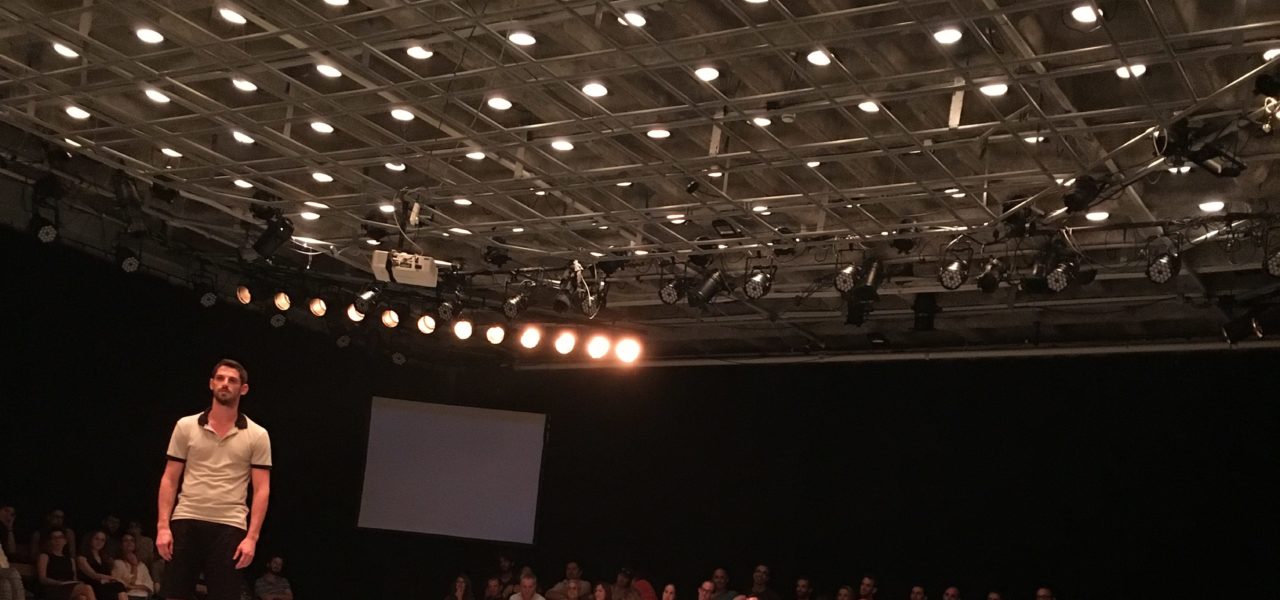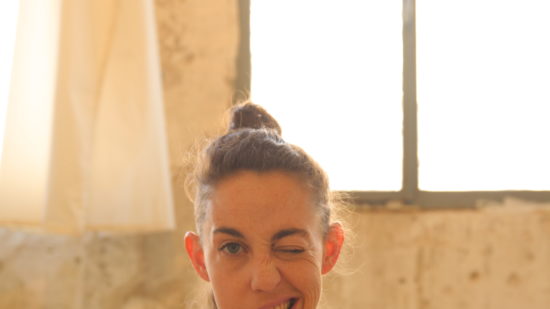Daphna Horenczyk on Project 48- Day 2

English Follows*
פרוייקט 48 מחול הוא מתנה ליוצרים, לרקדנים ולקהל.
מגבלת הזמן מחייבת את היוצר לסמוך על האינטואיציה, על הדחף הראשון, על האינסטינקט.
את הרקדן מגבלת הזמן מחייבת להנכיח מייד את היחודיות, החוזקות והכישורים שהכי זמינים לו, ובו בזמן היא “מנקה” אותו משיפוט עצמי ומאפשרת לו להנגיש את עצמו ליוצר. כך נוצר דיאלוג ישיר בין היוצר לרקדן.
בניגוד למופע שהוא תוצר של תהליך ארוך, בפרוייקט 48 אין זמן לבולשיט. זה ניכר וזה עובד.
עבור הקהל, פרוייקט 48 מאפשר חוויית צפייה במעבדה מופקת היטב, כלומר אנו לא צופים בתוצר וגם לא במחקר או בעבודה בתהליך. מוצג בפנינו רעיון כוראוגרפי, פרפורמטיבי או אינטלקטאולי ועל כן קריאת ה”טקסט המחולי” צריכה להיות בהתאם.
בשונה ממופע רגיל בו הקהל מצפה לעבור חוויה רגשית, אסתטית, רעיונית סוחפת (לעתים גם מטלטלת), בפרוייקט 48 מגיע הקהל מלכתחילה ללא ציפיות שכן אפקט ההגרלה וההפתעה מקבל תפקיד מרכזי במשחק.
חשיפת הקהל לנקודת הזינוק של המשתתפים במופע על-ידי הקרנת קטע הוידאו אליו התבקשו להגיב, פועלת כהנחת המסד לקריאת הטקסט הבימתי שיגיע בהמשך. האפקט של פעולה זו היא חיבור מיידי של הקהל עם היצירה המוצגת בפניו (מה שגורם לי לפנטז – לו רק היו שולחים לי קישור ליוטיוב לפני צפייה במופע מחול במקום להגיש לי תכנייה המתארת את המופע באותן מלים מעורפלות שפגשתי כבר עשרות פעמים במופעים קודמים….)
על פי עקרונות אלו, אוכל לשתף את חווייתי בשלוש מתוך חמש יצירות שהוצגו בפרוייקט 48 מחול – הערב השני.
2014, בית האח הגדול.
אורטל בן דיין כועסת. אשכנזי בור ונבער טוען שכל המזרחים הם בהמות. אין למזרחים תרבות דיון. הוא גזען. היא צועקת. יש שד עדתי, אין שד עדתי. מציעים לה כוס מים. הווליום והאמוציות גבוהים, המתח גובר עם הידיעה שעליהם לבלות 24/7 ביחד-לבד וזאת מול המצלמות שבצדן השני יושבים בבית מאות אלפי הצופים המשמשים כדיינים אשר גורל בני הבית בידיהם.
ואז, עם האות המוזיקלי נכנסים לבמה הרקדנים מורן אברג’ל יצחקי ועידן פורגס בתפקיד מנחי השעשועון “שבת תרבות” (שהוא גם שם היצירה מאת מאי זרחי ואופיר דגן). עיקר השעשועון הוא ניהול דיון בין הקהל לבין עצמו. בעוד הקהל עסוק בשיח סביב שאלות שהציגו המנחים, מתפרצים לבמה שני הרקדנים הנוספים שצוותו ליצירה זו. אלמוג דוד צועק ומתלהם עד כדי פרפורי גסיסה על רצפת הבמה, וגבע זייברט מנסה להשיב לו בשקט ובעדינות. כאשר המנחים מודיעים לזייברט על הדחתו מהמשחק, פורץ גם הוא בצעקות בקול ובגוף.
ואני תוהה – האם בסיטואציה של קהל במופע מחול יכול להתנהל דיון בצורה לא תרבותית? האם שיתוף הקהל במופע בצורה זו מהווה מניפלוציה כוראוגרפית המכוונת להיות הסחת דעת או בניה לקראת הדיון ה”לא תרבותי” המבויים שניהלו הרקדנים לאחר מכן? כך או כך, הנה הוכחה נוספת לכך שמי שצועק הכי חזק זוכה באהדה וברייטינג.
בקטע הבא, “אהבה” מאת נדר רוסנו בעזרתה של רות גוילי, אנו צופים במשך דקות ארוכות בהראל גרז’וטיס, איה דגני ומעין חורש כגוף אחד המנסה להקיא את נשמתו על הבמה. פתאום כצופה הרגשתי שאולי הפעם אני לא מעוניינת בפעולת ההצצה שמציע לי פורמט הריאליטי, ומה ההבדל בין הקאה מהסוג הפיזי והליטרלי ובין הקאה של המטען אותו פלטה אורטל בן דיין בבית האח הגדול? התנועה שיש ברפלקס ההקאה היא מרתקת ודוחה בו זמנית. החזרתיות והמשך של ההתעסקות בפעולה זו ביצירה איפשרה לי את המהלך המחשבתי הבא: כשהגוף מבקש לפלוט אינפורמציה אל אוויר העולם, הוא משתמש באותו עיקרון תנועתי – הצטברות של הפלט במעמקי הבטן, עליה דרך החזה ויציאה דרך הפה. פליטת האינפורמציה יכולה לקרות במצב של צחוק, כעס, בכי, שיעול וכמובן הקאה, כאשר אף אחד מהמצבים האלה לא באמת בשליטתנו, ולרוב מביאים להזדהות עם ה”פולט”.
ב”פרק ראשון: הכרות” דורון רז (בייעוצו האמנותי של רן בראון) מבקשת מגלעד ירולשמי, סחר דאמוני ושניר נקר להזדהות בזה אחר זה. תחילה על-ידי קטע סולו ריקוד, ולאחר מכן מול המצלמה בדיבור. לאחר מכן מתקיימים שלושת האינדיבידואלים במרחב אחד משותף, בדומה לפורמט של “האח הגדול”. בשונה מתכנית הריאליטי, הרקע ממנו מגיעים הרקדנים והשפה (התנועתית והמילולית) לא שונים בצורה קצונית, ועל כן המרחב המשותף נשאר הרמוני וללא התנגשויות
Project 48 is a gift to choreographers, dancers and the audience.
The time constraint forces the artist to trust his or her intuition, impulses and instincts.
The time constraint forces the dancer to immediately offer up the individuality, strengths and talents that are available while simultaneously “clearing away” any self-criticism or doubt. It allows the dancers to make themselves available to the choreographers, creating a direct dialogue.
As opposed to a creative process that spans many months, in Project 48 there is no time for bullshit.
This is apparent and it works. For the audience, Project 48 allows a vantage point on a well-orchestrated laboratory. We receive something that is not the final product, an experiment or a work in progress. In front of us is a choreographic, performative or intellectual idea, and all viewing of such “dance text” must be in done with this in mind.
As opposed to a regular performance, where the audience expects to undergo an emotional, aesthetic, captivating (occasionally disturbing) experience, in Project 48, the audience arrives with no preconceived notions. The effect of the lottery and the surprise factor are central to this game.
The audience’s exposure to the jumping-off-point of the artists, video clips that the participants were asked to respond to, acts as a fundamental direction in how to view the pieces to come. This creates an immediate connection between the audience and the works ahead (which makes me wonder, what if before seeing a show, instead of reading a program with the same all too familiar vague words, I was sent a YouTube link…)
Based on these principles, I can share my experiences from three of the five works presented in Day 2 of Project 48 Dance.
2014, Big Brother house.
Ortal Ben Dayan is angry. An ignorant and boorish Ashkenazi claims that all Mizrahim are animals. Mizrahim don’t have a culture of debate. He’s racist. She yells. There is an ethnic demon, there is no ethnic demon. They offer her a glass of water. Volume and emotions run high, the tension is intensified by the knowledge that they must stand out 24/7 together- alone in front of cameras on the opposite side of which sit hundreds of thousands of viewers in their homes, judges who will determine the tenants’ fates.
And then, right on beat with the music, dancers Moran Abergel Itzhaki and Idan Porges enter the stage as the hosts of the gameshow “Shabbat of Culture” (which is also the name of the piece, by May Zarhy and Offir Dagan). The concept of the gameshow is to create a dialogue amongst the audience. While the audience is busy with questions handed out by the hosts, the two other dancers of the group burst onto the stage. Almog David is outraged to the point of palpitating on the floor of the stage while Geva Zaibert tries to answer him quietly and gently. When the hosts inform Zaibert of his elimination, he explodes in screams with his voice and body.
And I wonder- is it even possible to have an uncivilized conversation in this situation? Is the participation of the audience in this show a choreographic manipulation meant to distract the viewer or is it a build up to the directed, “uncivilized” conversation that follows? Either way, here’s another example of the fact that whoever yells the loudest gets the highest rating.
In the next bit, “Love” by Nadar Rosano and Ruth Gvili, we watch for many long minutes as Harel Grazutis, Aya Degani and Maayan Horesh, as one body, try to vomit their guts out on stage. Suddenly I felt that as an observer I wasn’t interested in the act of peeking, which the reality show format offers. And what is the difference between the physical, as imitated on stage, and the verbal, as Ortal Ben Dayan’s in the Big Brother house, acts of vomiting? The movement of their gag reflex is fascinating and repulsive at once. The repetition and duration of this act leads me to the following thought: when the body attempts to expel something into the world, it uses the same movement principle- gathering the vomit in the depths of the stomach, pushing it up to the chest and ejecting it out through the mouth. Be it laughter, anger, crying, coughing or, of course, throwing up- the movement is the same. In all of the above situations, the “vomiters” have little or no control over their bodies and we as witnesses can’t help but identify with them.
In “Chapter 1: Introduction”, Doron Raz (with artistic advisor Ran Brown) asks Gilad Jerusalmy, Sahar Damoni and Snir Nakar to identify themselves. It begins with solo dances and continues on camera in speech. Afterwards, the three individuals are placed in a common space, similarly to Big Brother. Unlike the reality show, the background of the three (movement-wise and verbally) are not drastically different and as such, the common ground they share remains harmonious and collision-free.

Daphna Horenczyk is a dance artist based in Munich, Germany. Born in 1987 in Tel Aviv, Israel, Daphna started dancing at the age of 15. She graduated from the professional dance training program in Kibbutz Ga’aton. After one year of working as a dancer and rehearsal director, she moved to Salzburg to study in SEAD both in the performance and choreography programs. During her studies, she created 3 pieces which had toured in Europe and Israel. In 2012 Daphna went back to Israel, where she was performing her own choreographies, as well as a dancer for choreographers such as Ayelet Yekutiel, Guy Bernard Reichmann and Ariel Cohen. Her pieces performed in festival such as Machol Shalem, Intimadance (IL), No Ballet (DE), MAAT (PL), PAD Mainz (DE) and more. Currently Daphna is working as a contemporary dance teacher and dancer in Munich and abroad.
